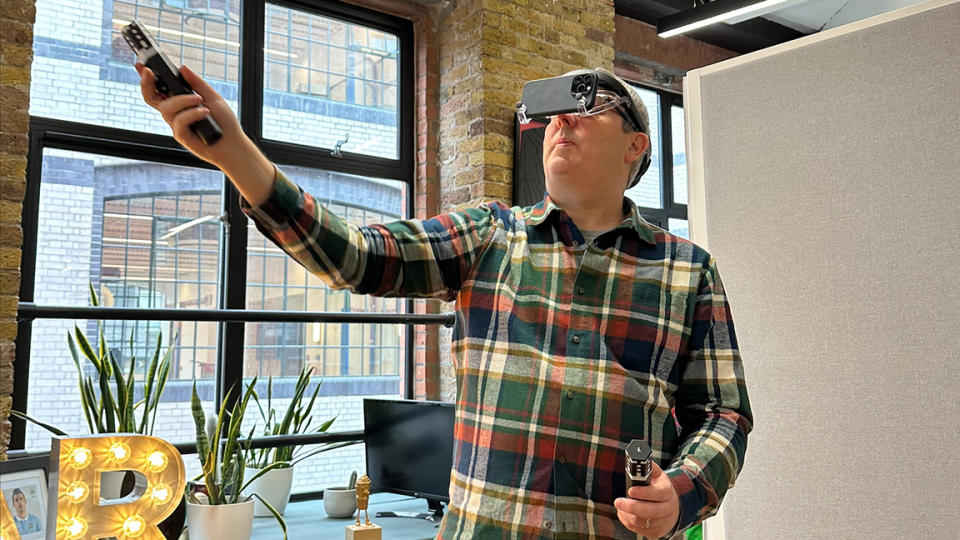Can't stomach the price of an Apple Vision Pro? Then Zapbox could be the AR gateway gadget for tapping into 3D creativity you've been looking for. I recently paid a visit to Zappar, makers of Zapbox, a new AR device designed to turn your iPhone into a 'Vision Pro lite'. It's not VR but AR, using passthrough video, Lidar, and the tech inside an iPhone to create 3D interactive spaces in front of me, and it works really nicely.
I've tried AR before with mixed results, but Zapbox is different. The idea is a little like the old Google Cardboard. A lightweight frame sits over my head and an iPhone slots into a cradle in front of my eyes. The difference is Zappar has picked up on the good design ideas from the best VR headsets, for example there's an adjustable strap and dialled clamp to tighten the headset as found on PlayStation VR2, and tailored these to an iPhone-powered head strap and controllers.
Similar to a gaming headset, and unlike using other phone-based AR and glasses, Zapbox is packaged with a pair of AR 'wand' controllers that look and feel like an evolution of Sony's old PlayStation Move Controller. On the top is a small thumbstick, face buttons and below a trigger.
This pair of controllers is the difference between Zapbox and standard AR and AR glasses. I'm using Zapbox with the newly released Open Brush - it's essentially Tilt Brush relaunched - and it means I can hold a 'palette' of brushes and colours in my left hand while painting and colour-picking using the right controller. It's effortless and is a far better use of AR than using heavy glasses and inaccurate controls.
VR artist Sean Rodrigo, whohas 20 years experience of using this kind of tech to create with, says: "One of the things that's a real problem with the Apple Pro is that it doesn't have any controllers. Having a physical controller makes a lot of sense […] because painting your hands is not something that I do".
It's an aspect of Vision Pro Sean hasn't been keen on and feels Zapbox is doing so well, because VR and AR is about breaking away from the rigid way you're used to working on a computer and finding a "human centric" method of creating. While Vision Pro's gesture controls sound good, "it can create a barrier between you and an achieved goal," says Sean, who likens it to learning sign language. Controllers on the other hand, are easier to use out of the box.
I find myself agreeing, the wand-like Zapbox controllers offer an immediate and natural way to begin creating in 3D, in AR. I can jab and create strokes of paint, access menus and flip between brushes and colours, and it all feels easy, with fewer obstacles in the way.
Sean sees Zapbox as a cost effective entry point for artists, game developers and anyone who needs to quickly create or demo a scene in spatial 3D. An iPhone shares similar processors and sensors to entry-level VR headsets like Meta Quest 3 and Pico, so it's more than capable of running spatial 3D apps, like Open Brush.
Given the power and tech inside an iPhone, Sean says, "it makes a lot of sense that our phone becomes the main vehicle for using virtual reality". The Zapbox is piggybacking onto iPhone and "using a processor that's consistent with the Meta Quests or the Pico, any of these headsets are all using the same chips or comparable chips […] functionality it's very, very similar".
I spent an afternoon in London trying out Open Brush on Zapbox, and I loved it. When Google dropped Tilt Brush it made the code open source, so the canny folk behind the spatial painting app ran with it and made Open Brush from the carcass of Google's failure. It means Open Brush feels like Tilt Brush, and is four letters away from being largely the same great app.
I'm able to paint live in front of me, and using the Zapbox setup I can create in AR, meaning I can see everyone around me as I doodle. Better yet, using Zapbox's neat AR features I can set a nearby table as my base from which to paint trees, growing from it.
Painting in AR is unique. I do what many new users do, and create 2D images in a 3D space - it's how we're used to creating but in AR creation is unique. I squiggle a basic tree and then realise to give it form I need to paint in and out of my viewable world, arcing strokes to form the shape of a tree canopy and branches.
The wide palette of brushes helps me to quickly get creative, and Open Brush's range of flashing neon colours, light strips and cartoon-style strokes mix with thick paint brush marks, organic dapples and more to ensure my imagination can wander.
The Zapbox headset is lighter, and cheaper, than a Meta Quest 3 and given the tech inside iPhone is getting close to Vision Pro for passthrough AR, and the controllers are a far more intuitive way to 3D paint than crab-pinching and virtual finger painting, being able to create and share digital art made in AR on iOS is an innovative idea.
Sean points out how by appropriating iPhones as the workhorse of Zapbox, the setup is tied into Apple's operating system, he says potentially you'll be able to share files inside AR to other iOS devices, "which means you can bypass your computer and therefore do a lot extra on your phone". He adds, "because it's in the same ecosystem it could have the same functionality as a $3,000 headset".
When not doodling digital art in a virtual space I was surprised to discover Zapbox also supports spacial 3D video, just like Vision Pro. You need the latest iPhone 15 Pro or Pro Max but you can watch video in AR, scrub through footage, and even capture and share spatial video.
Zapbox feels like it removes the barriers of entry into AR for many artists and teams who have yet to try this approach, and at $99 / £99 it's far less a costly investment than a Vision Pro headset. Paired with Open Brush, I think Zappar has hit the cost effective AR magic sauce with Zapbox.



